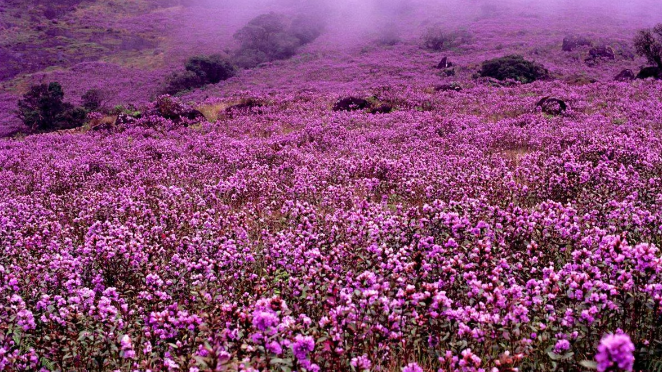Neelakurinji: The Endangered Purple Bloom of the Western Ghats (GS Paper 3, Environment)

Introduction
- The Neelakurinji (Strobilanthes kunthiana), a flowering shrub endemic to the montane grasslands of southwest India, has recently gained international attention due to its addition to the International Union for Conservation of Nature (IUCN) Red List of Threatened Species.
- This classification of "Vulnerable" underscores the critical state of this unique plant, which is celebrated for its once-in-a-lifetime blooming phenomenon every 12 years.
The IUCN Red List Assessment
First Global Evaluation
For the first time, Strobilanthes kunthiana has been evaluated on a global scale by the IUCN Red List. The assessment was conducted by:
- Dr. Amitha Bachan K.H.
- Devika M. Anilkumar
These experts are affiliated with the Centre for Ecology Taxonomy Conservation and Climate Change (CEtC) at the Western Ghats Hornbill Foundation, located within the Research Department of Botany at MES Asmabi College, Kodungalloor. The assessment was further reviewed by Aparna Watwe of the Western Ghats Plant Specialist Group to ensure comprehensive and credible results.
Challenges in Assessment
Dr. Bachan noted several factors that have historically complicated the assessment of Neelakurinji:
- Complex Distribution: The plant's distribution spans montane sky island landscapes in the Western Ghats, a region characterized by its complex topography and ecological diversity.
- Unique Blooming Cycle: Neelakurinji's extraordinary 12-year blooming cycle makes it difficult to study and monitor regularly.
- Limited Ecological Research: A lack of extensive ecological studies has impeded efforts to understand the full scope of the plant's ecological needs and threats.
Neelakurinji: A Botanical Marvel
Species Characteristics
Strobilanthes kunthiana is known for its remarkable botanical features:
- Height: The shrub can grow up to three meters tall.
- Habitat: It is found exclusively in high-altitude shola grassland ecosystems.
- Elevation Range: The plant thrives at elevations between 1,340 and 2,600 meters.
- Geographic Range: It occurs across five distinct mountain landscapes in southwest India, including the Nilgiris, Munnar, Palani-Kodaikanal area, and Anamalai mountains.
Blooming Phenomenon
The Neelakurinji is famous for its spectacular blooming event:
- Blooming Cycle: It blooms once every 12 years, creating a breathtaking purplish-blue landscape.
- Visual Impact: This synchronized blooming event covers vast areas in a vibrant display of color, attracting significant attention from botanists and nature enthusiasts alike.
- Life Cycle: Neelakurinji is semelparous, meaning it blooms once before dying. This mass blooming and fruiting is a critical part of its reproductive strategy.
- Historical Documentation: Blooming patterns have been documented since 1832, providing valuable historical context for the plant's ecological behavior.
Threats to Neelakurinji
Habitat Loss and Degradation
The primary threats to Neelakurinji include:
- Conversion of Natural Habitats: Approximately 40% of its natural habitat has been lost due to:
- Tea Plantations: Expansion of agricultural activities has significantly altered its natural habitat.
- Softwood Plantations: Monoculture plantations replace diverse natural ecosystems.
- Urbanization: Increasing human settlements encroach on the plant's natural ranges.
- Invasive Species: Remaining habitats face pressure from invasive species such as:
- Eucalyptus: Competes with native flora for resources.
- Black Wattle: Alters soil chemistry and disrupts local ecosystems.
- Infrastructure Development: Ongoing construction projects contribute to habitat fragmentation and loss.
- Misguided Conservation Efforts: Certain afforestation programs disrupt natural grassland ecosystems, further threatening the plant.
- Climate Change: Alterations in temperature and precipitation patterns impact the delicate montane ecosystems that Neelakurinji depends on.
Distribution and Population
- Area of Occupancy: The plant occupies about 220 square kilometers.
- Extent of Occurrence: It is spread across approximately 25,510 square kilometers.
- Subpopulations: There are 34 known subpopulations:
- 33 in the Western Ghats: Representing the bulk of its distribution.
- 1 in the Eastern Ghats: Located in Yercaud, Shevaroy Hills.
Key Habitats
The Neelakurinji's primary habitats include:
- Nilgiris of Tamil Nadu: Hosts the largest concentration of the species.
- Munnar Region: Another critical area for the plant.
- Palani-Kodaikanal Area: Important for its diverse montane ecosystems.
- Anamalai Mountains: Provides crucial habitat for the species.
Conservation Implications
- The inclusion of Neelakurinji on the IUCN Red List as Vulnerable highlights the urgent need for targeted conservation efforts.
- Its Vulnerable status (Criteria A2c) indicates a significant population reduction of at least 30% over the last three generations.
- This decline is attributed to factors such as habitat loss, invasive species, and climate change.
Conclusion
- Neelakurinji, with its extraordinary and rare blooming cycle, is more than just a botanical curiosity; it is a critical component of the Western Ghats' biodiversity.
- Its recent addition to the IUCN Red List underscores the importance of immediate and effective conservation measures.
- Protecting Neelakurinji's habitats and addressing the threats it faces is essential for preserving this iconic species and maintaining the ecological balance of the Western Ghats.
- By advancing conservation strategies and raising awareness, we can ensure that future generations will continue to witness the remarkable beauty of Neelakurinji and safeguard the rich biodiversity of this unique region.


